Army Vehicles at Monterey’s Fort Ord
During Fort Ord’s 20+ years as a barren maneuvers area and 50+ years as an active U.S. Army installation, its personnel, facilities, and equipment were a visible presence throughout the Monterey Peninsula. From its activation in 1940 until it was shut down in 1994, Fort Ord was primarily a basic training base and later home of the service’s Seventh Infantry Division (Light).
At various times several units were assigned to Fort Ord that utilized specialized vehicles to carry out their respective missions. The ones that are illustrated below and on the following pages span a variety of technologies and uses based upon tactical requirements. Spoiler alert: the focus on specialized vehicles in this section means that there are no Jeeps, 2.5-ton trucks, 5-ton trucks, or Humvees, as these vehicles were quite common at Fort Ord and every other U.S. Army base.

At top are two vehicles that served at Fort Ord: an LVT(A)-1 amphibious tank is at left and an M29 “Weasel” is at right. Details on these and other vehicles are on subsequent pages. Bottom, this 120-foot sign at Ford Ord’s main gate greeted everyone entering the base from the nearby town of Seaside in the 1980s. (Top left and right, Defense Language Institute Foreign Language Center Digital Repository; bottom, courtesy of Monterey Herald)
• • • •
M2A4 Tank
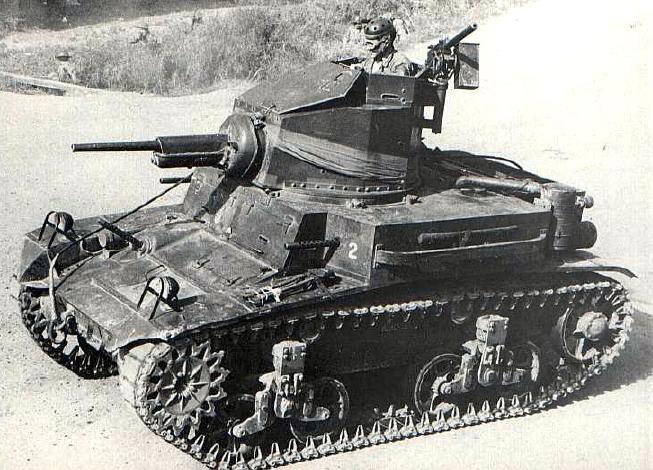
This M2A4 light tank is like the ones in the 757th Tank Battalion at Fort Ord just prior to the U.S. entering World War II; its 37mm gun and four of five machine guns are visible. (Public Domain via Wikimedia Commons)
The 757th Tank Battalion was based at Fort Ord where it operated earlier M2 series tanks before receiving the M2A4 with its 37mm gun starting in September 1941.
Previous M2 versions were solely equipped with machine guns. Observations of combat in the Spanish Civil War of the mid-1930s led to a change in the U.S. military’s preparedness for a future conflict. In this case, armored warfare in Spain revealed that the current M2 tanks would not be useful. As a result, the M2A4 was developed to include a 37mm anti-tank gun, five .30-caliber machine guns, thicker armor plate. A 250 hp Continental W-670 9A seven-cylinder radial engine powered the vehicle. Production of 375 M2A4s took place from May 1940 to April 1942, resulting in its status as the primary light tank at the start of U.S. engagement in World War II. However, the M2A4 was used in combat only by the U.S. Marines in the Battle for Guadalcanal. By that time, the other M2A4 tanks had shifted into training roles due to the introduction in April 1942 of the M3 Stuart tanks that were later used extensively in Europe.
Regarding the history of the 757th Tank Battalion, after Pearl Harbor the unit patrolled various portions of the West Coast for a time due to the fear of invasion by Japanese forces. They deployed to North Africa in March 1943 and moved with Allied forces into Italy in the fall of 1943. Here the unit successfully supported various infantry units until it was sent home in June 1945.
• • • •
M3A1 Scout Car
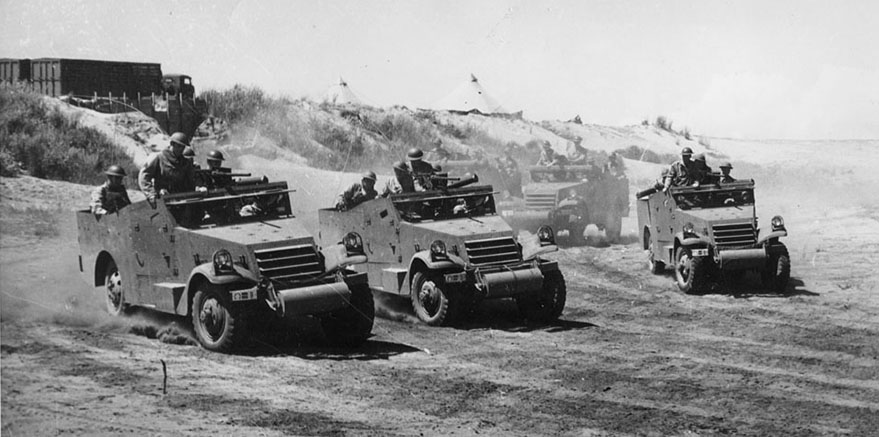
Fort Ord’s 107th Cavalry Regiment trains in a simulated attack on an enemy position on May 1, 1942 during their conversion from horses to motor vehicles. (Cal State Monterey Bay, Digital Commons@CSUMB)
This image illustrates the 107th Cavalry Regiment in transition from a horse cavalry unit to a mechanized force. During the conversion process, units like the 107th utilized railway transport and motor vehicles to ship personnel and equipment to a new location. However, because they still utilized horses to carry out tactical missions, they had specialized truck/trailer combinations called Portées to haul their horses between duty stations. In the photograph two of the 107th’s Portées are visible on top of the sand dune in the background. Their presence indicates that the transition is incomplete, the 107th and other units were dually identified as horse-mounted and mechanized.
As the U.S. military started preparing for inevitable participation in World War II, the 107th was activated into Federal service on March 15, 1941, thus temporarily changing its status from an Ohio National Guard unit. Training as traditional mounted cavalry was halted after Pearl Harbor, when the unit was transferred to Fort Ord. The 107th was then tasked with carrying out horse-mounted patrols of the California coast from the Golden Gate to Carmel as part of the defense against an invasion by Japanese military forces.
In the spring of 1942, the 107th became fully mechanized by completely re-equipping with M3A1 Scout Cars. The M3A1 was the last version of the M series of armored cars built by the White Motor Company that were initially produced in 1934 as a militarized derivative of their commercial half-ton truck. Subsequent versions were produced in small numbers until deliveries of the M3A1 began in 1939 and ramped up dramatically when the U.S. joined the war in 1941. Armed with one .50-caliber machine gun and two .30-caliber guns, the M3A1 was used for reconnaissance and as an armored command vehicle by the U.S. Army as well as several allied nations through Lend-Lease. The Marines also deployed M3A1s in the Pacific Theater in noncombat roles. M3A1 production reached approximately 20,900 vehicles by 1944. By that time the M3A1 had been replaced by the more capable M8 Armored Car and M20 Utility Car.
• • • •
Light Cargo Carrier M29 “Weasel”
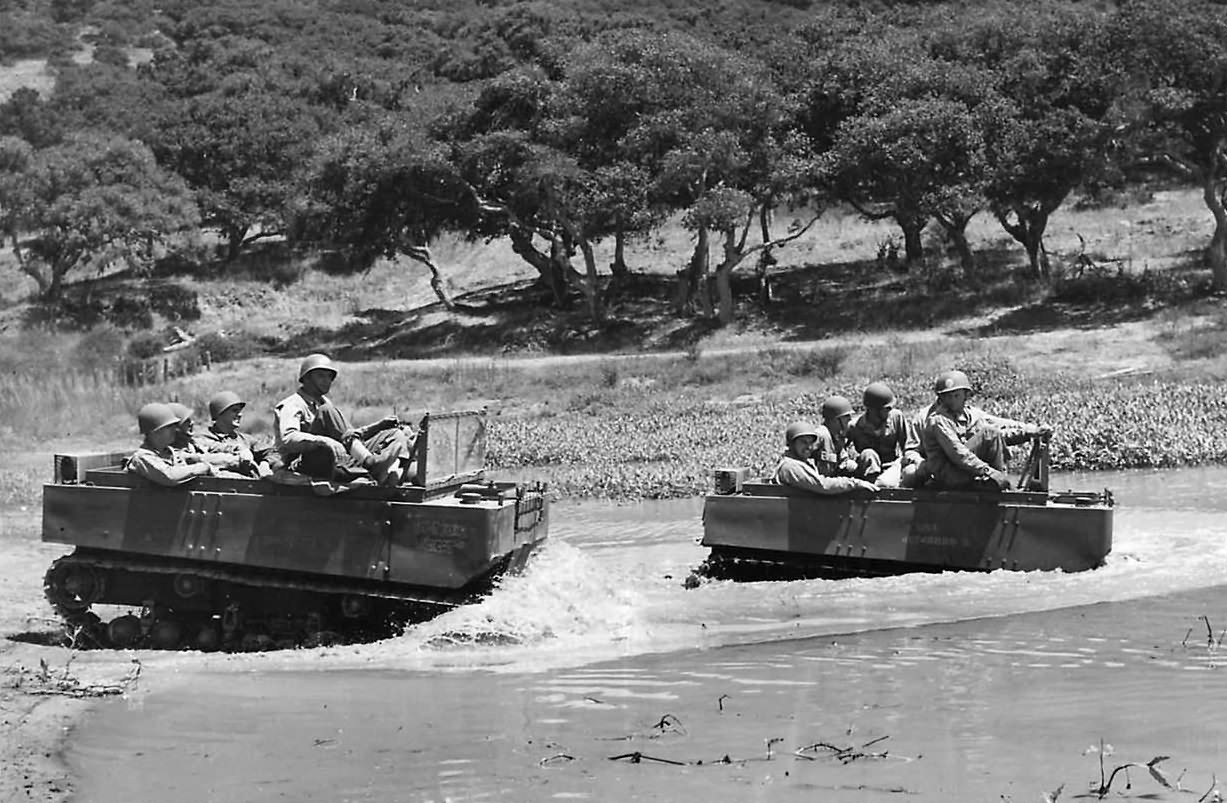
A pair of early M29 Weasels enter a water hazard while undergoing testing by Army Ground Forces Replacement Depot No. 2 troops at Fort Ord sometime in mid-1944. (Cal State Monterey Bay, Digital Commons@CSUMB)
A special mission requiring a highly specialized transport was the basis for the development of the Light Cargo Carrier M-29, commonly identified as the Weasel. The idea for the Weasel is attributed to a British scientist named Geoffrey Pyke. He believed that a planned commando-style mission to destroy strategic power plants in Norway in 1942-43 required that the attacking force have a fast and light mechanized transport able to carry small teams across snow. The vehicle also needed to be able to be carried by aircraft and rugged enough to withstand being airdropped.
The mission was eventually cancelled, but not before the Studebaker Company produced a prototype in only 60 days of 180 allotted for the project. This initial design was designated T-15, then later M-28. It was a tracked vehicle whose light ground pressure of less than two pounds per square inch made it seemingly float across snow. Studebaker produced about 1,000 M28 Weasels before making enhancements that resulted in a new vehicle carrying the designation T-24 before being renamed M29. The new M29 was tested in all sorts of difficult terrain, including in field tests at Fort Ord as seen above, and was found to be excellent in transporting personnel and cargo in all environments. Performance metrics include an 11-inch ground clearance, three-speed transmission, ability to cross a ditch up to four feet wide, climb 24 inches over a vertical obstacle, range of over 160 miles, and a top speed of 36 mph. The M29 proved to be adaptable to varied roles such as a command vehicle, ambulance, and for communications wire-laying. This versatility led to the use of the M29 in all of the fighting areas during World War II, with the result that over 15,000 were built by the end of the war. A later amphibious version called the M29C was used by the military until its retirement in 1958. They also supported scientists and explorers in Arctic and Antarctic operations from the late 1940s into the early 1990s. Surplus Weasels were also sold off in the 1950s to civilians, particularly ski resorts, and municipal organizations.
• • • •
Landing Vehicle, Tracked: LVT(A)-1
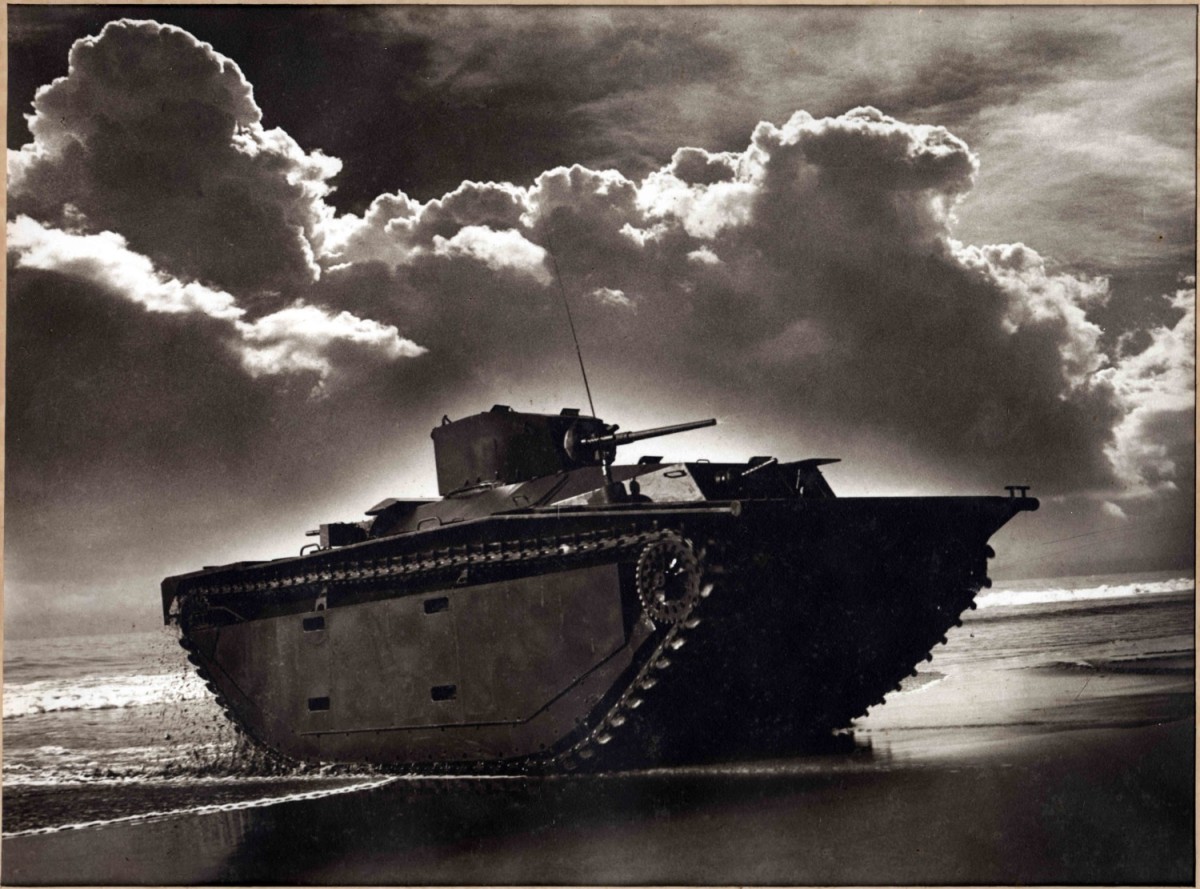
An LVT(A)-1 Amphibious Tank comes ashore during a training exercise near Fort Ord. (Army.mil)
During World War II, a unit at Fort Ord was activated in November 1943 to carry out a unique mission: training crews to operate armed amphibious vehicles in amphibious landing operations. The 18th Armored Group (Amphibious), under the command of Col. William “Terry Bull” Triplet, had to start from scratch, because Army manuals on amphibious operations at the time did not include anything about their vehicles and their employment. The amphibious vehicles assigned to the unit were of two related models. The first was an amphibious troop transport officially designated Landing Vehicle, Tracked (LVT), but more commonly called the “Alligator”. It featured four machine guns mounted at each corner and was open at the top due to its transport role. Utilizing an LVT as a basis, the LVT(A)-1 carried a six-man crew in a fully enclosed structure that had a small turret mounted on top. The turret held a 37mm gun as primary armament, with an additional .30-caliber machine mounted separately below and in front.
The 18th’s training role was vital to the successful use of the amphibious vehicles and the crew’s survival. While operating at sea in training, an inattentive or careless mistake could be fatal to man and machine. Col. Triplet therefore instilled a focus on realism early in the program’s initiation. For example, 18th personnel utilized every means available to simulate enemy fire while trainees carried out mock beach landings along the Monterey coast.
Through close cooperation with the Marines, who also used the two amphibious vehicles, the 18th Armored Group conducted tests that led to the production of the LVT(A)-4. This version had a 75mm gun in place of the 37mm, and proved to be more effective against strong points.
The Army eventually deployed 23 LVT battalions in amphibious operations in both theaters, utilizing tactics developed by the “Saltwater Cowboys” of the 18th. The 18th continued training operations at Fort Ord until the unit was deactivated in November 1945.
• • • •
M48 Patton Main Battle Tank
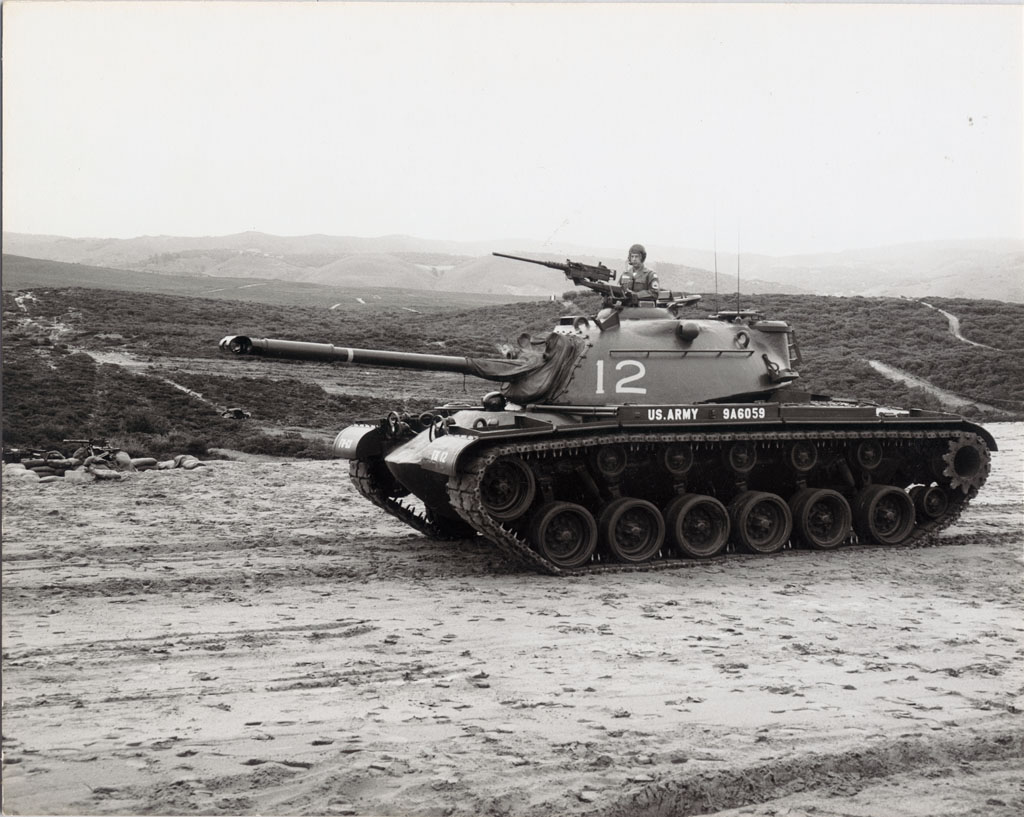
A pristine M48 tank assigned to an unidentified unit is seen on one of the ranges at Ford Ord on an unknown date. (Cal State Monterey Bay, Digital Commons@CSUMB)
Although Fort Ord’s primary mission shifted to basic training of Army recruits after World War II and it remained in that role for over 25 years, small numbers of tanks were periodically based there into the 1960s. Tank units from other bases periodically trained at Fort Ord during the period as well. For these reasons, the prominence of the M48 Patton Main Battle Tank in the Army’s post-Korean War inventory makes it likely that the unidentified tank above and others like it were based at Fort Ord at times as well as equipping units that trained there.
The M48 was developed from the preceding M47 Patton that was initially developed to meet the need for an advanced tank to counter numerically superior Soviet equipment during the Cold War. Problems with the M47 and subsequent improvements essentially constituted a new design and designation that became M48, named for General George S. Patton, Jr., the legendary armor tactician and commander of the Third Army during World War II.
The urgent need for the new tank resulted in three contracts awarded in 1952 for approximately 400 tanks each to Chrysler, General Motors Fisher Body Division, and Ford Motor Company. A fourth contract was awarded to American Locomotive Company, Schenectady, NY, in 1953. The first production M48 was produced by Chrysler and unveiled on July 1, 1952. Production versions of the M48 spanned the M48A1 – M48A5 to overcome deficiencies and add capabilities. Basic metrics include a weight of 49.6 tons, length of 30 feet, 6 inches with gun forward, width of 12 feet, and a height of 10 feet, 2 inches. All variants had a top speed of approximately 30 mph with different versions having a range of 70 to 310 miles.
The M48A3 was the primary Army tank used in Vietnam where its powerful 90mm gun was sometimes replaced with a flamethrower for special targets. It was also exported to West Germany, Greece, Israel, Pakistan, South Vietnam, Spain, Taiwan, and Turkey. By 1973, the M48 had been virtually replaced by the M60 and was finally retired by the Army National Guard in 1987.
• • • •
Barge, Amphibious Resupply, Cargo (BARC)
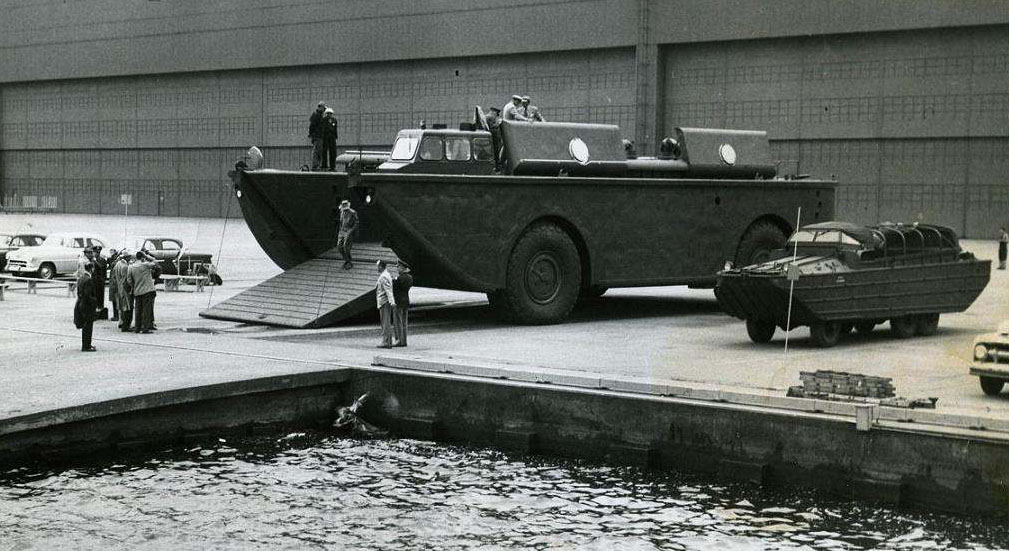
The experimental BARC 3-X (third experimental prototype) dwarfs a standard GM DUKW that it was designed to replace. The BARC was a welded steel-hulled amphibious cargo vehicle that could carry up to 100 tons of cargo or 200 personnel, but typically its load was 60 tons of cargo or 120 troops. (Public Domain via Wikimedia Commons)
During the Korean War, the Army recognized the need for a replacement of its DUKW six-wheeled amphibious trucks, nicknamed “Ducks”, originally built during World War II by General Motors. As part of an overall plan to improve delivery of cargo in military operations, Deputy Chief of Army Transportation Major General Frank Besson envisioned the use of large amphibious vehicles that would transport personnel and materiel from ships onto beach areas. A contract for development and testing of four prototypes was awarded to Pacific Car and Foundry, Renton, WA, in the early 1950s. The company worked with offshore oil rig manufacturer LeTourneau to design and build the vehicles dubbed Barge, Amphibious Resupply, Cargo, or BARC.
The BARC was a massive vehicle at over 62 feet long, 26 feet wide, 19 feet high, and weighing 194,000 lbs. It could easily carry a fully equipped infantry company of 125 men or haul sixty tons of cargo. Cargo was loaded onto the BARC from overhead when alongside ships and unloaded via the hydraulically-operated bow ramp onto the beach. When operating on land each of the BARC’s four 165 hp 6-cylinder General Motors diesel engines drove one of its four 9.5-foor diameter wheels. As a water vessel, propulsion was provided by the two left-hand (port) engines driving a propeller on the left side while the two right-hand (starboard) engines drove a propeller on that side. Maximum speed on land when empty was 20 mph and on the water was 9 miles per hour.
BARC 1-X underwent testing at Fort Ord but sank in heavy seas on March 17, 1953, while being towed to San Francisco. Its three crewmen were lost in the accident, which was attributed to excessive towing speed and a series of mechanical failures. When prototype testing was completed the Army took delivery of 55 BARCs. In 1961, a BARC platoon was assigned to Fort Ord until its deployment to Viet Nam in 1965. They remained in service redesignated as LARC (Lighter Amphibious Resupply, Combat) until the last one was retired in 2001.


